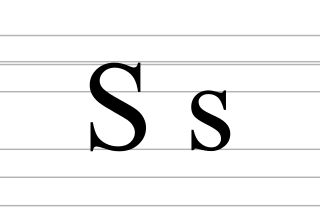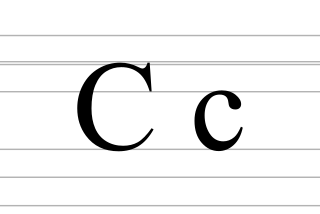
D, or d, is the fourth letter of the Latin alphabet, used in the modern English alphabet, the alphabets of other western European languages and others worldwide. Its name in English is dee, plural dees.

E, or e, is the fifth letter and the second vowel letter of the Latin alphabet, used in the modern English alphabet, the alphabets of other western European languages and others worldwide. Its name in English is e ; plural es, Es or E's.

F, or f, is the sixth letter of the Latin alphabet and many modern alphabets influenced by it, including the modern English alphabet and the alphabets of all other modern western European languages. Its name in English is ef, and the plural is efs.

G, or g, is the seventh letter of the Latin alphabet, used in the modern English alphabet, the alphabets of other western European languages, and others worldwide. Its name in English is gee, plural gees.

K, or k, is the eleventh letter of the Latin alphabet, used in the modern English alphabet, the alphabets of other western European languages and others worldwide. Its name in English is kay, plural kays.

M, or m, is the thirteenth letter of the Latin alphabet, used in the modern English alphabet, the alphabets of other western European languages and others worldwide. Its name in English is em, plural ems.

N, or n, is the fourteenth letter of the Latin alphabet, used in the modern English alphabet, the alphabets of other western European languages, and others worldwide. Its name in English is en, plural ens.

O, or o, is the fifteenth letter and the fourth vowel letter of the Latin alphabet, used in the modern English alphabet, the alphabets of other western European languages and others worldwide. Its name in English is o, plural oes.

P, or p, is the sixteenth letter of the Latin alphabet, used in the modern English alphabet, the alphabets of other western European languages and others worldwide. Its name in English is pee, plural pees.

R, or r, is the eighteenth letter of the Latin alphabet, used in the modern English alphabet, the alphabets of other western European languages and others worldwide. Its name in English is ar, plural ars, or in Ireland or.

S, or for lowercase, s, is the nineteenth letter of the Latin alphabet, used in the English alphabet, the alphabets of other western European languages and other latin alphabets worldwide. Its name in English is ess, plural esses.

EzhEZH, also called the "tailed z", is a letter, notable for its use in the International Phonetic Alphabet (IPA) to represent the voiced postalveolar fricative consonant. For example, the pronunciation of "si" in vision and precision, or the ⟨s⟩ in treasure. See also the letter ⟨Ž⟩ as used in many Slavic languages, the letter ⟨Ż⟩ as used in Kashubian, the Persian alphabet letter ⟨ژ⟩, the Cyrillic letter ⟨Ж⟩, the Devanagari letter (झ़) and the Esperanto letter ⟨Ĵ⟩.

Esh is a character used in phonology to represent the voiceless postalveolar fricative.

L, or l, is the twelfth letter of the Latin alphabet, used in the modern English alphabet, the alphabets of other western European languages and others worldwide. Its name in English is el, plural els.

Heng is a letter of the Latin alphabet, originating as a typographic ligature of h and ŋ. It is used for a voiceless y-like sound, such as in Dania transcription of the Danish language.

J, or j, is the tenth letter of the Latin alphabet, used in the modern English alphabet, the alphabets of other western European languages and others worldwide. Its usual name in English is jay, with a now-uncommon variant jy.

C, or c, is the third letter of the Latin alphabet, used in the modern English alphabet, the alphabets of other western European languages and others worldwide. Its name in English is cee, plural cees.
Unicode supports several phonetic scripts and notation systems through its existing scripts and the addition of extra blocks with phonetic characters. These phonetic characters are derived from an existing script, usually Latin, Greek or Cyrillic. Apart from the International Phonetic Alphabet (IPA), extensions to the IPA and obsolete and nonstandard IPA symbols, these blocks also contain characters from the Uralic Phonetic Alphabet and the Americanist Phonetic Alphabet.
In typesetting, the hook or tail is a diacritic mark attached to letters in many alphabets. In shape it looks like a hook and it can be attached below as a descender, on top as an ascender and sometimes to the side. The orientation of the hook can change its meaning: when it is below and curls to the left it can be interpreted as a palatal hook, and when it curls to the right is called hook tail or tail and can be interpreted as a retroflex hook. It should not be mistaken with the hook above, a diacritical mark used in Vietnamese, or the rhotic hook, used in the International Phonetic Alphabet.

![]() , Syriac Taw ܬ, and Arabic ت Tāʼ) via the Greek letter τ (tau). In English, it is most commonly used to represent the voiceless alveolar plosive, a sound it also denotes in the International Phonetic Alphabet. It is the most commonly used consonant and the second-most commonly used letter in English-language texts. [2]
, Syriac Taw ܬ, and Arabic ت Tāʼ) via the Greek letter τ (tau). In English, it is most commonly used to represent the voiceless alveolar plosive, a sound it also denotes in the International Phonetic Alphabet. It is the most commonly used consonant and the second-most commonly used letter in English-language texts. [2] 






















